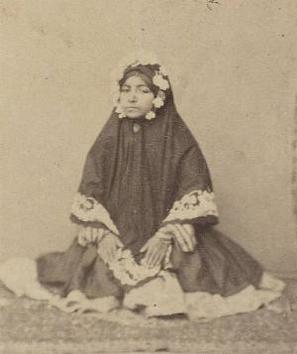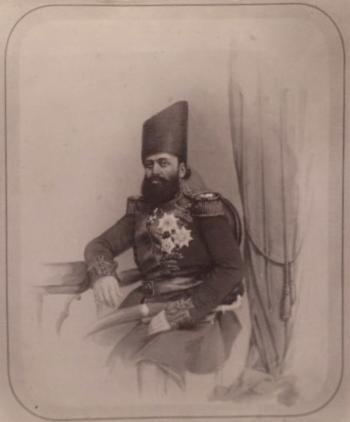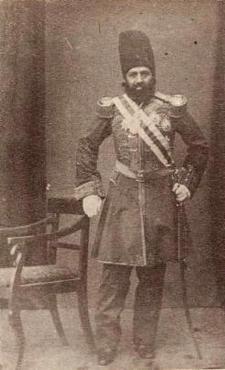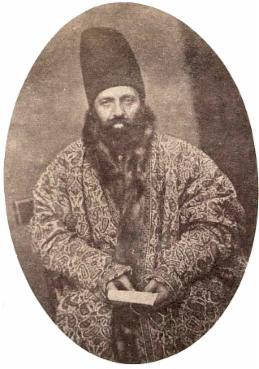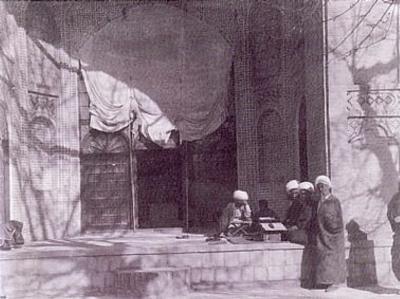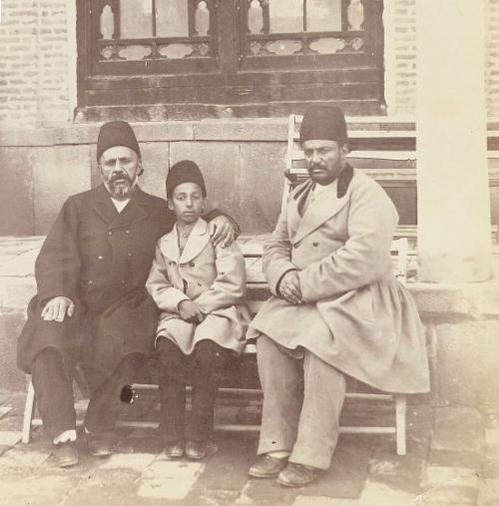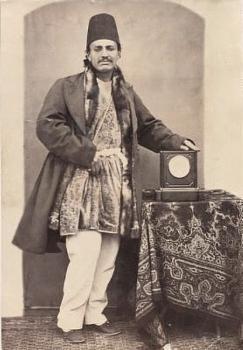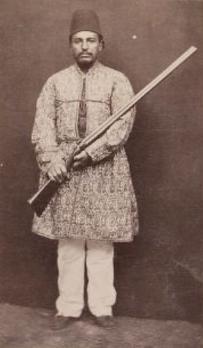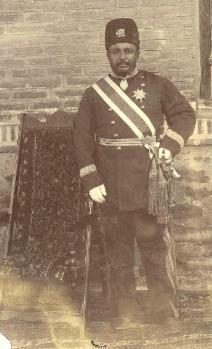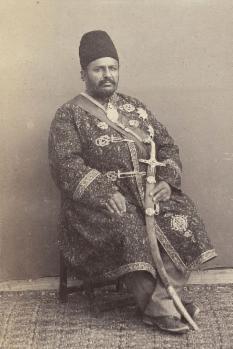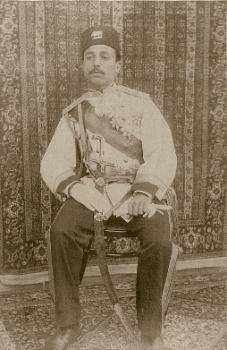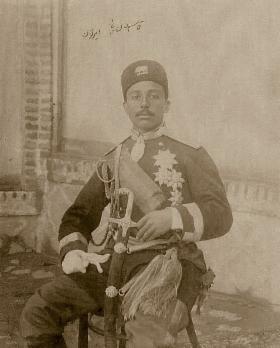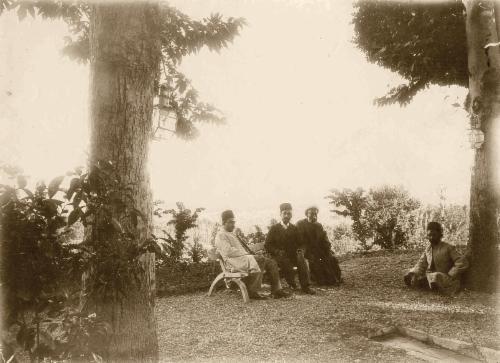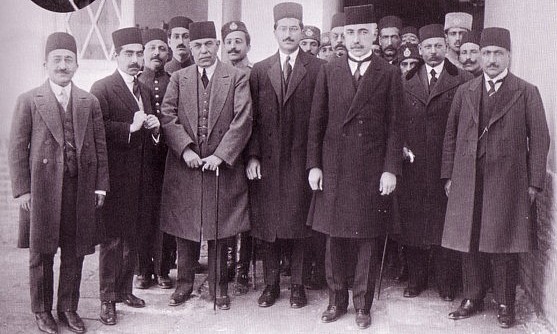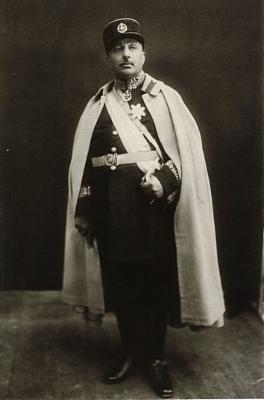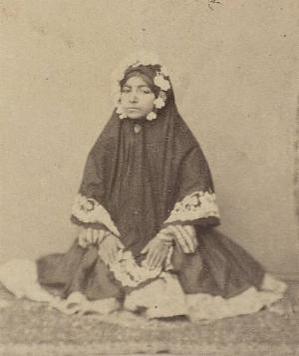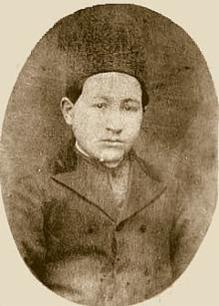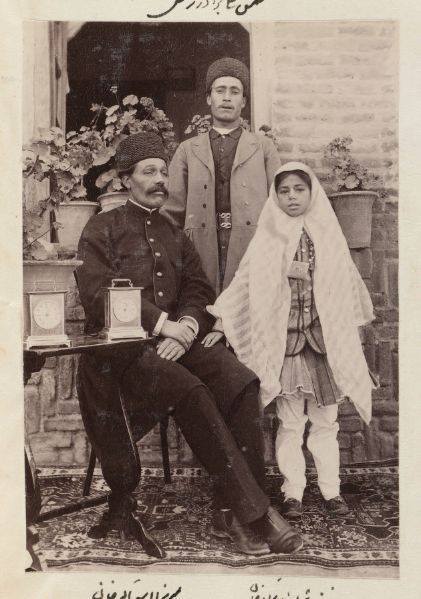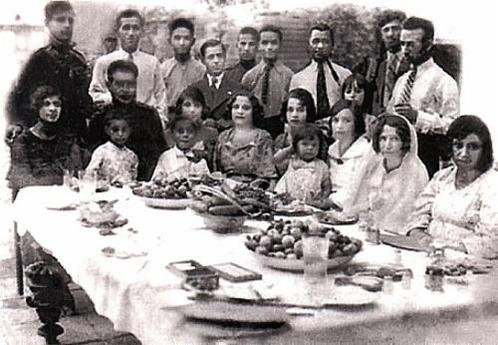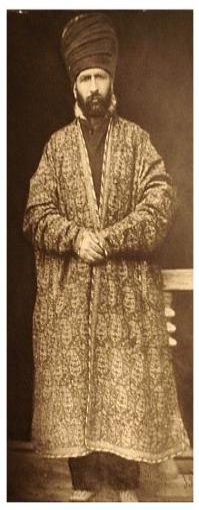Roghiyeh Khanom Wali's own family were our Wali ancestors....
The House of Wali - Vicegerents and Viziers
Originally the descriptive title (
onwan) of Wali was the designation of a semi-autonomous provincial vicegerent or "Lord of the Marches", a powerful prince at the Western borders of the Persian Empire. These hereditary rulers were since Safavid time vassals of the shah and when the Q
ajars installed their power replacing these local emirs, finally the term was also used for governor-generals of important districts instead of the more tribal connected term of beyglarbeygi (lit. "Lord of the Lords"). The House of Wali (sometimmes also written "Vali") was an older side line of the
Moayyeri Family, a well-known aristocratic branch itself that took part in the history of the later Qajar and early Pahlawi era. It traced back to our common forefather Mohammad Qassem Khan W
ali, who was known with his two sons by the name of W
ali, which at last became the family’s surname in 1930:
1.2.2. Mohammad Qassem Khan Wali (1805-1872) Mohammad Qassem Khan Wali (sometimes only called
Qassem Khan Wali) was born probably about 1805 at Tehran as the second son of Dust Ali Khan (I) Bastami “Moayyer ol-Mamalek” by Kh
ajiyeh Khanom and grandson of Hossein Ali Beyg Bastami “Moayyer ol-Mamalek” (for their line see:
The Moayyeri Ancestors). Firstly, 1838-1840
Mohammad Qassem Khan was vice-governor (
nayeb-e wali) of the central Iranian province of Yazd on behalf of his elder brother Hossein Ali Khan “Moayyer ol-Mamalek” during the reign of
Mohammad Shah. In 1840 he was succeeded by his nephew Dust Ali Khan II. After 1848 he belonged to Nasser od-Din Shah’s palace administration and then became the shah’s chamberlain (pish-khedmat). In 1851 he was designated Iranian consul-general in the
Georgian capital city of Tiflis instead of Ahmad Khan “Amin ol-Molk”. In 1854, after his return, Moh
ammad Qassem Khan was made advisor and deputy to the Iranian ambassador to Russia, Abbas Ali Khan Nuri “Seyf ol-Molk”. In 1855 he participated in the accession of
Tsar Alexander II to the throne of Russia as Iranian Chargé d’Affaires. 1855-1860, after the ambassador’s return, Mohammad Qassem Khan stayed at St. Petersburg and lastly was given the post of Iran’s Minister Plenipotentiary (
wazir-e mokhtar) to Russia. In 1860, after resigning his post, he made a trip to Europe with his younger son Ali Khan, and visited Berlin, Brussels, Paris and London. From Marseille both went to Istanbul and after a short while there, they crossed the Black Sea from Trebizond and Erzurum, and crossed the Iranian border at Ovacik. They travelled via Tabriz, Zanjan and Qazvin back to Tehran. In February 1861 they met
Mohammad Qassem Khan’s nephew Dust Ali Khan II “Moayyer ol-Mamalek”, and rendered homage to His Majesty the Shah in Shahrestanak, next to the town of Karaj, 40 km in the West of Tehran. 1861-1862
Mohammad Qassem Khan was appointed deputy governor of Yazd a second time and received honourably the designation (
onwan) of
Wali by the shah. 1862-1868
Mohammad Qassem Khan W
ali became not only in name but in real governor-general (
wali) of the north-Iranian Caspian littoral province of Gilan, before on March 23 1871 he took over the vizierate of the province of Fars and office of custodian (
pishkar) for Nasser od-Din Shah’s eldest son Prince Soltan Massud Mirza “Zell os-Soltan”. On April 22 he left Tehran for the provincial capital and residence of
Shiraz and was given the post of Hajji Mohammad Qoli Khan Davalu “Asaf od-Dowleh”. On June 19 1871 he himself was assigned to governor-general of Fars by the shah, after the latter had deposed his own son. During the great famine in Iran of 1871, with especially hit the province of Fars, Mohammad Qassem Khan erected several poorhouses (called after him
Qassemiyeh) and ran six of them by his own, counting 50 to 600 beds. On March 21 1872 Mohammad Qassem Khan Wali the governor of Fars died of typhoid fever at his residence in Shiraz and was buried there in the mausoleum of Persia’s famous poet Hafez, called
Hafeziyeh.
Mohammad Qassem Khan Wali is the grandfather of the Wali (Vali) and Valizadeh families and had issued two sons: Mohammad Khan Wali and Ali Khan Wali.
Mohammad Qassem Khan Wali in the uniform of Iran's envoy and in the robe of a local vizier.
The tomb of Mohammad Qassem Khan Wali the governor of Fars in the Takht-e Qawwam Mausoleum at the Hafeziyeh in Shiraz. The photograph was taken by Albert Hotz, 1890.
1.2.2.1. Mohammad Khan Wali (1843-1891)
Mohammad Khan Wali was born in 1843 at Tehran as the elder son of Mohammad Qassem Khan Wali and grandson of Dust Ali Khan (I) Bastami “Moayyer ol-Mamalek”. He was educated 1852 as one of the
first pupils at the Dar ol-Fonun polytechnic school of Tehran, and finished his studies in artillery in Paris. Mohammad Khan Wali’s career started in 1860 as First Secretary and Deputy Envoy
(niyabat-e sefarat) to his father when the later was minister plenipotentiary in St. Petersburg. In 1865 he was made governor of Yazd. In 1871, under his father's governorship he became
member of the provincial government of Fars. In 1872, after the death of his father, whom he served as deputy, Mohammad Khan Wali first returned to Tehran and got there his father's laqab of
Wali. 1873-1879 he was made governor of Yazd a second term and in 1886 got the command about Azerbaijan, where he was 1886-1891 governor of Khoy and Shahpur (Salmas). On August 24 1891 he died by
stroke in Khoy. Even Nasser od-Din Shah received a letter about the Wali's death and noticed in his diary that on Sunday, August 24 1891 the Wali took dinner the night before, went to bed and
the next morning has passed away.
Mohammad Khan Wali firstly was married his cousin Mehr-e Jahan Khanom, called "Yazd Khanom", eldest daughter of Dust Ali Khan II Moayyer ol-Mamalek Nazem od-Dowleh by his chief wife Begom Mah
Nessa Khanom. With Yazd Khanom he issued Mahmoud Khan Walizadeh and Asadollah Khan Walizadeh governor of Sabzevar, the fathers of the Vali and Valizadeh lines and a daughter called Valizadeh Khanom.
After the death of his first wife he married secondly Bibi Hajjar Khanom Isfahani, the daughter of the Sadr-e Isfahani family, by whom he issued in Yazd two daughters and one son, Roghiyeh Khanom
Wali (b. at Yazd ca. 1876, d. at Tehran 1910) and Ameneh Khanom Wali (b. at Yazd ca. 1880, d. at Tehran 1913), who both were married to their distant cousin Agha
Mirza Ali Akbar Khan "Nasr-e Lashkar", and finally Bagher Khan "Nezam Wali", personal atendant to the crown prince, who succeeded his
father as governor of Yazd.
Painting of Mohammad Khan Wali.
Mohammad Khan Wali governor of Khoy, Qassem Khan and Ali Khan Wali 1889 in Khoy.
1.2.2.2. Ali Khan Wali (1845-1902)
Ali Khan Wali probably was born in 1845 at Tehran as the younger son of
Mohammad Qassem Khan Wali and grandson of Dust Ali Khan (I) Bastami “Moayyer ol-Mamalek”
. Because his father
Mohammad Qassem Khan often was on diplomatic missions, Ali Khan firstly grew up in his uncle Hossein Ali Khan’s house. In 1855 he accompanied his father to St. Petersburg, where he was educated until 1860 in French, history, temporary geometry and geography, and learned the art of photography there. In 1860 he toured with his father throughout Europe, returned to Tehran and in 1863 went with him to Gilan, where his father held the post of governor-general. There Ali Khan took care about the provincial capital of Rasht and its public order, supervised the construction of a road to Iraq and headed the pony express along the way to the town of Manjil. In 1868, after his father’s resigning, Ali Khan became private chamberlain (pish-khedmat-e khass) to Nasser od-Din Shah and the special companion of the royal tour to the northern provinces of Iran. 1870-71 Ali Khan accompanied the shah to the Shiite shrines of Najaf, Kerbala, and Kazemiya in Ottoman governed Iraq. 1871, when Moha
mmad Qassem Khan Wali was assigned to Fars, Ali Khan Wali took residence in the capital city of Tehran and belonged to the imperial entourage. There in the district of Darband, at Tehran’s northern neighbourhood of Tajrish, was the estate of Ali Khan called "Saadabad" (lit. "Place of Joy") in a huge 60 ha area situated above the township of Shemiran, called
Teppeh-ye Ali Khan (this area in the slopes of Alborz Mountain later was used by Reza Shah Pahlawi to build his
Saadabad Palace). After his father’s death in 1872, Ali Khan stayed in office as special attendant to the shah until 1878. In 1878 he entered service of Crown Prince Mozaffar od-Din Mirza (the later shah, r. 1896-1905) and received some offices in Azerbaijan: In 1879 he was entrusted with the governorship of Maragheh (h
ukomat-e Maragheh), a town in Azerbaijan, which a year later he defended successfully against raids of Kurdish rebels. This was the first of a series of posts he was to hold in that region, including governor (
hakem) of the cities of Urmiyeh, Maragheh 1886, Salmas and Ardabil in Azerbaijan 1891 and Sanandaj in Kurdistan, in 1894 he became governor of Ardabil a second time. Ali Khan Wali died 1902 in Tehran and was buried at Qom.
One of Ali Khan’s passions shared with the shah was photography, and he became a prominent photographer and edited a huge
album of photography. He illustrated his reports to the central administration in Tehran with photographs of provincial landscapes, buildings and the rural population. This was an innovation encouraged by Nasser od-Din Shah but readily accommodated by Ali Khan due to his personal interests. (To see an article about his work:
click here.)
Ali Khan married firstly Homa Khanom, daughter of Mirza Said Khan Ansari "Mo'tamen ol-Molk", Minister of Forreign Affairs 1853-1873 and 1880, by whom he issued Assiyeh Khanom "Ehteram ol-Shari'eh" (who was married to Agha Sheikh Lori "Soltan ol-Olama" a renown cleric) and Qassem Khan Wali (II) “Sardar Homayun”. In 1890 he married Tuba Khanom from the Amiri family of Ardabil and issued by her Haydar Qoli Khan, Mehdi Qoli Khan and Maryam Khanom (who all died in their youth).
Ali Khan Wali as young photographer, on the hunt, in governor's uniform and in official garb.
1.2.2.2.1. Qassem Khan Wali “Sardar Homayun” (1878-1933)
Qassem Khan Wali entitled “Sardar Homayun” (lit. “Most August Commander”) by the shah, was born about 1878 and the eldest son of Ali Khan Wali and grandson of Mohammad Qassem Khan Wali. Because of his father’s position at court, he received military honours still in youth. He was sent 1889 with his
laleh Mirza Mohammad Sadegh "Saheb Nasaq" to Paris and the first Iranian army general to graduate from the prestigious Saint-Cyr Military School in France, which was founded by Napoleon Bonaparte in 1802. Firstly, Qassem Khan started a political career and became 1908 first Mayor of Tabriz, where he introduced the first electrical engineer and metallic printing press in Iran. In 1916 Qassem Khan was member of the cabinet of Prime Minister Mirza Hassan Khan “Vossugh od-Dowleh”, and in 1919 he was made commander of the Iranian troops by the British General William Edmund Ironside. In that time Ironside was commander of some 6,000 British troops in Iran (called “North Persian Expeditionary Force”) with headquarter in Qazvin. He distrusted Russian loyalties after the 1917 October Revolution and with the assistance of Herman Norman, the British Minister in Tehran, persuaded Soltan Ahmad Shah (r. 1909-1925), the last Qajar shah, to dismiss the more than hundred Russian officers of the Persian Cossack Division to replace them with loyal Iranians under the command of an alley to British interests. Thus, as a well educated and disciplined military man and some anglophile, Qassem Khan was encouraged by the local politicians and moderates, backed by the British government, to accept this post. (An opportunity that also gave him the chance maybe to become the future Shah of Persia with an overthrow of the Qajar dynasty – the fact that his lineage could be connected with the Qajars gave added incentive to have him on this post.) But in 1920 he refused the appointment out of fear for his family’s safety and to his moral reluctance to use the aid of alien powers and force against countrymen to maintain monarchy. Finally Ironside selected Lieutenant Colonel Reza Khan (the future Reza Shah Pahlawi) as the Russian’s successor. This was made on the advice of his British officer friend Col. Henry Smyth, who was much impressed by Reza's Persian contingent under the tutelage of Prince Farmanfarma. Ironside wanted a strong military commander in the capital to save the country from the Bolsheviks and chaos and safeguard the imminent withdrawal of NORPERFORCE from Persia. In return, Reza Khan promised not to hinder British withdrawal or depose the shah and was encouraged with his coup d’état of 1921 and at least the founding of the Pahlawi dynasty in 1925. Under the reign of Reza Shah Pahlawi (r. 1925-1944) Qassem Khan was given the military title of Amir-e Lashkar (lit. “Commander of the Army”, i.e. Lieutenant-General), was appointed commander of the Cossack Division in Northern Iran and attended the Pahlawi coronation ceremonies on April 25 1926. He retired soon after to his family’s estate of Saadabad at
Teppeh-ye Ali Khan in Tehran’s north to pursue writing and farming. He died at Urmia (Rezayieh) on August 14 1933.
Qassem Khan Wali “Sardar Homayun” married Mashraf os-Saltaneh Khanom and had issued five daughters and two sons, among them Mariyam, Homa, Ebrahim
Wali and Ali Wali (d. 1983), who have served in the imperial army as army general during the reign of Mohammad Reza Shah Pahlawi (r. 1941-1979).
Qassem Khan Wali “Sardar Homayun” in fully decorated uniform of a military dignitary, 1900.
Family estate of Saadabad at Teppeh-ye Ali Khan. From left to right sitting on a bench: Ali Khan Wali, Qassem Khan and Agha Sheikh Lori "Soltan al-Olama". Far right a house servant.
The first cabinet of Vossugh od-Dowleh, 1916. From left to right: Mirza Ahmad Khan "Nasir od-Dowleh", Prince Firuz Mirza "Nosrat od-Dowleh", Qassem Khan Wali “Sardar Homayun”, Fathollah Sepahdar Rashti, Akbar Mirza "Sarem od-Dowleh", Reza Qoli Khan "Nayer ol-Molk", Mirza Hassan Khan "Vossugh od-Dowleh", Mirza Mohammad Khan "Mohaseb ol-Mamalek", Mirza Hassan Khan "Moshar ol-Molk".
Qassem Khan Wali “Sardar Homayun” in the era of Reza Shah Pahlawi as Lieutenant-General.
Roghiyeh Khanom Wali at the age of twelve, 1889.
Mirza Asdollah Khan Wali with his granddaughter Shams on-Nahar and a servant.
The Wali family in sprintime 1938. Standing: Mehdi Zarrinnaal, Mahmoud Wali, Gholam Ali Wali, Davood Zarrinnaal, Ahmad Zarrinnaal, Mostafa Wali, Jawad Zarrinnaal, N.N., Mohsen Wali. Sitting: Talat ol-Molouk Zarrinnaal, Mohammad Ali Zarrinnaal with little Nasser Zarrinnaal, Zarrin-Homa Zarrinnaal, Malek-Taj Zarrinnaal, Shams on-Nahar Wali, Aghdas Wali, Ashraf ol-Walieh and Ehteram ol-Walieh.
Ancestry line:
Mohammad Qassem Khan Wali > Mohammad Khan Wali > Roghiyeh Khanom Wali > Kazem Khan Zarrinkafsch > The House of Zarrinkafsch (Bahman-Qajar)
Sources:
Kamran Adle, "Ali Khan the Governor" in: IRAN the architectual journal, June 2006, p. 1-8.
Alī Khan Wālī: The Photograph Collection of the Golestan Palace: The Album of Photographs by Ali Khan Vali. Qajar, edit. by Jeff Spurr, Boston: Research Department of Harvard University, 2006, Internet: September 2008, http://nrs.harvard.edu/urn-3:FHCL:1125271.
Mehdi Bāmdād: Sharh-e hāl-e rejāl-e Īrān dar qorūn-e 12 wa 13 wa 14, 6 vols, Tehran: Ketābforūšī-ye Zawwār, 5th edit., 1378 H.š. [1999]; vol. III, p. 126-13.
Hassan Fasā‘ī: Fārsnāmeh-ye Nāsserī, transl. and edit. by Herbert Busse, History of Persia under Qājār Rule, New York & London: Columbia University Press, 1972, p. 374-376.
Cyrus Ghani: Iran and the Rise of Reza Shah, London & New York: I.B. Tauris, 2000, p. 140 ff.
Dūst 'Alī Mo'ayyeri: Rejāl-e 'asr-e nāsserī, Tehran: Nashr-e tārīkh-e Īrān: Majmū'a-ye motūn wa esnād-e tārīkhī. Ketāb-e dahom (Qāğār), p. 83.
Klaus Dieter Streicher: Die Männer der Ära Nāsir: Die Erinnerungen des Dūst 'Alī Hān Mu'ayyir al-Mamālik, Frankfurt am Main: Verlag Peter Lang, 1989 [Heidelberger Orientalische Studien, Band 12], p. 20 ff.
Interview with Mrs Manijeh Wali, Hamburg, 1995.
This website was created by Arian K. Zarrinkafsch (Bahman-Qajar).

